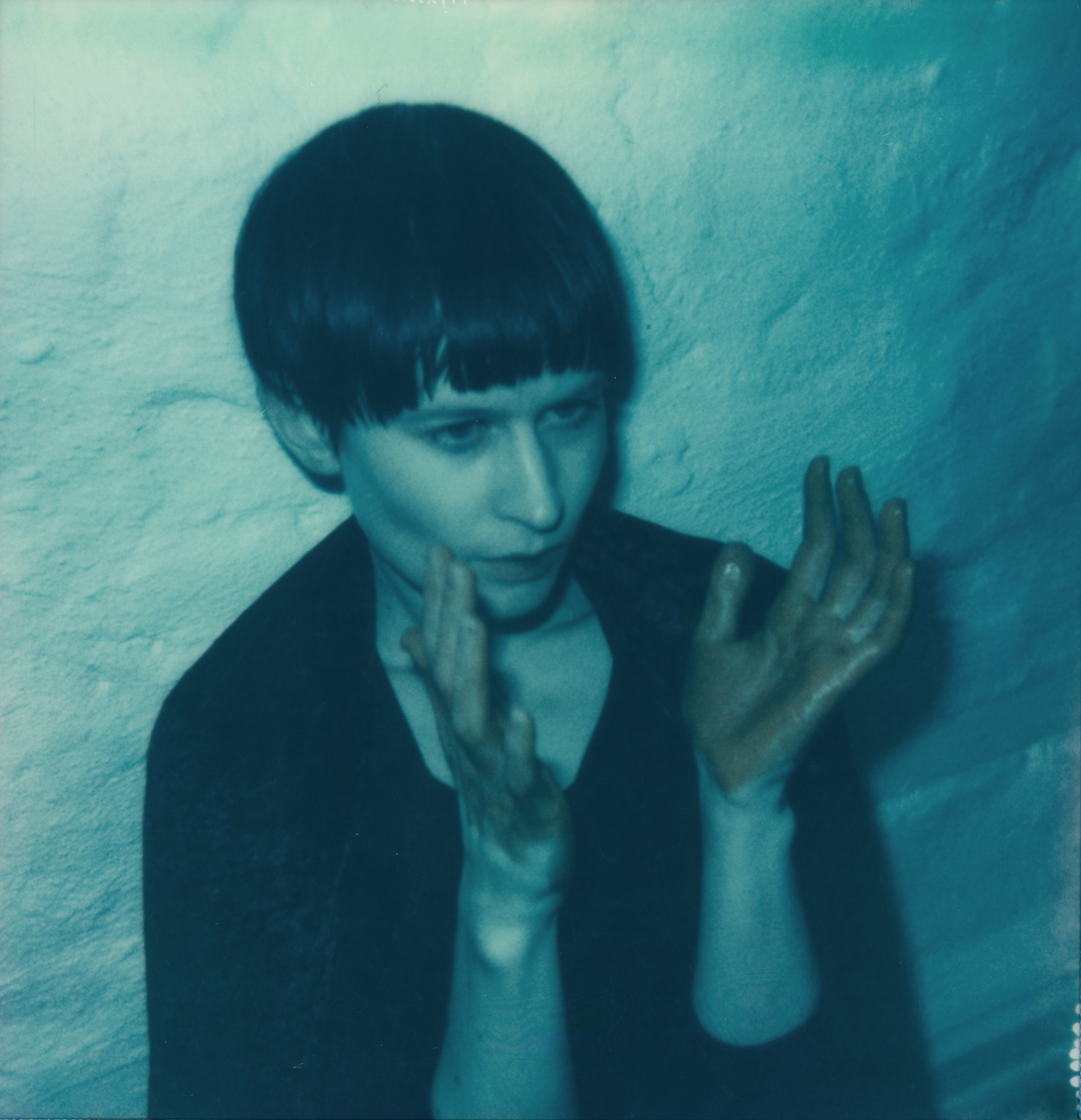 Jenny Berger Myhre
Jenny Berger Myhre
“Vampires must be so bored,” says Jenny Hval with a dry laugh. “You know, eternity is really boring.” In her deadpan Norwegian accent, she’s describing over Skype how the disjointed, dreamlike plots of 1970s and ‘80s horror movies provided an unexpected stylistic blueprint for her new album Blood Bitch. Strangely, she tells me, she found the lethargic pace of these kitsch movies spiritual; even inspiring. “I think the surrealism of certain films from that era is very practical. It’s about the low budget, and the people making the film wanting to make it so fast that it's not considered finished by proper studio standards. But I found that [style] very liberating.”
But while the surrealism of these B-movies might have been an accidental by-product, it’s a quality that Hval revels in on Blood Bitch. Just as a 1970s vampire movie cannibalized trends from Hollywood, but reframed them in an off-key way, so Hval’s latest release inches closer than ever toward mainstream pop structures. On her sixth release in a decade, she playfully brushes against the polished melodies of radio hits, yet simultaneously, she warps these familiar patterns into something uncanny, luxuriating in weird images and crackling, crude textures.
Inescapable throughout the album and Hval’s discussion of it is the presence of blood. Lyrically, the album portrays a bloodthirsty romantic hero who she names in the press release as “a vampire Orlando” in reference to Virginia Woolf’s centuries-old, gender-switching character. She flits between a sense of sinister bloodlust and a life-affirming celebration of blood (specifically menstrual blood). Blood, of course, also looms large in the imagery of the ‘70s movies Hval absorbed, whether used as a symbol of desire or fertility, or simply a scare tactic. There are female vampires who seek to drain men of their blood, young girls who are awakened by their first period, and the spine-straight shock of seeing gushes of red that never seems to get old. Over a long call from her studio, Hval talked through six of her favorite films from the genre and the impression they left on her. Dive in below, and as Hval sings on “Period Piece”: Do not be afraid, it’s only blood.
1. Female Vampire (1973)
 Jesús Franco
Jesús Franco
JENNY HVAL: This film is a constant cycle of kills. There's the blood version where she sucks blood, and there's the sex version where she sucks semen. This movie is terribly boring, but you can't stop watching it. It’s like porn; porn is also really boring. You are actually, as a spectator, being eternal. It's very spiritual movie watching; like going to the underworld and being stuck there and being a vampire, experiencing eternity.
I'm not sure that the “Female Vampire” in my album is necessarily a villain. She's more like a touring musician. Just stuck. Stuck in Groundhog Day, but on tour. Same city every night. It reminds me of a being stuck in capitalist structures. Being stuck in jobs that don't pay. Never getting proper pay for what you do. You wonder, "My future is nothing but working more and more and not being able to survive? It's not going to change?" Precarious existence. I think that's the modern vampire existence.
2. Messiah of Evil (1973)
 Willard Huyck and Gloria Katz
Willard Huyck and Gloria Katz
This is like a zombie film made in an art context, surrounded by visual arts. There are some really classic, beautiful scenes in this movie. One of them is the zombies in the supermarket, hunting someone who's just trying to grab some food. Then there’s the cinema sequence, which is famous. It's in a cinema, and [the character] realizes all the people who are watching are just waiting to eat her. It's like film eating itself. It's film being a zombie, eating its own art.
Very simple elements in this film inspired me. Like colors, the fact that there was art in a zombie context, the fact that high and low art were placed in the same context. I love that, and I do think of my work like that too, like putting melodies and noise elements in the same context.
3. Valerie and Her Week of Wonders (1970)
 Jaromil Jireš
Jaromil Jireš
[This film is] from the Czech new wave movement, which was a very strong avant-garde movement in the ‘60s, ‘70s. In the beginning of the film, the main character Valerie gets her period, and you can see blood dripping onto flowers. It's very beautiful, and it's rare that a film depicts menstruation in that powerful and colorful and beautiful way. That's the start of her awakening, which then becomes terrifying, but also erotic and surrealist and complex. But it’s wonderfully guilt-free. It's removed from that specifically American moral trauma, [which] it’s unusual now to see images removed from. [The moral panic is] reinforced so much, no matter how much you discuss sexuality in modern times. Even if it's the artist [whose image was deleted] from Instagram, the girl in the bed with the period stain — it's trapped always in the conversation of whether it's taboo or not. But in this film, it's not discussed at all whether it's taboo or not. It's just like this wonderful magic potion that starts off this world of images. It's more like a kaleidoscope.
When you start menstruating it really doesn't mean much, it certainly didn't to me, it wasn't like I turned into a butterfly or anything like that. But I think most people can remember how the world sort of changes when you become aware of people as sexual beings. It's very scary to discover that, and it's also very secret and wonderful and all things at once. The world becomes very tactile, and the film manages to do the same.
4. Black Moon (1975)
This film is hard to talk about because I just remember images. Images of characters changing, and not in a CGI, modern way; more like a real dream. Like, one minute, your mother's your mother, and the next minute it's your mother's body but it's you. In that sense, it resembles my memories of a childhood nightmare.
I found some narrative parts interesting. Like, the main character is driving through a war zone, because there's a war between the sexes — men and women are at war with each other. Which might've seemed true for some people in the ‘70s, I'm sure. But the way it's done, I really like it. It's scattered and surrealist. It's just happening around the film’s central characters and narratives, it's not really important. That to me is lovely, taking misogyny out of context, and [depicting it as] helpless and not representing power, but just stupidity or something more abstract. It's cathartic. Surrealist images can sometimes be a release...it makes your brain jump off into its own world of creativity. Frees up something.
5. Possession (1981)
The interesting thing about Possession is that it's a very realist narrative, but with a very over-the-top symbol in it. It's about a couple, and their relationship is pretty bad, and it turns out she has an affair. That's what, for a long time, you think the movie is about. But she really is having an affair with a creature — a supernatural, or at least non-human creature. You don't really see it until the very end of the film, so it just becomes really creepy. It’s like a regular family drama that becomes really terrifying.
One of the scenes that I really loved in this film is the miscarriage. Which is amazing. These types of scenes — like, humans mating with supernatural creatures and then this incredible miscarriage — brought me back to the idea of the vampire. I loved it, this non-human desire in her that brings her back to this creature. Desire for something that's not another person. I found I could draw that into my album world: undefined, untamed desire.
6. Carrie (1976)
 Brian De Palma
Brian De Palma
We talked about Carrie throughout the making of the album. Horror films make such a mess, and Carrie in particular makes such a mess. The girl covered in blood — to me there's always something delightful about it. Because even if it's trashy and it's grotesque, there's an element of almost erotic, or childlike erotic, pleasure in it, because it's a mess. I've been dealing with mess onstage a lot over the past year, like rubbing in too much cream on the skin, putting on too much makeup, having people onstage putting on makeup throughout the entire show.
[Menstruation] is something that is most of the time kept unseen; when it becomes seen, it's magnified. I think of my album as trying to make everything really tactile, textured, and big, but without being magnified in that way. You don't see the menstrual blood as a taboo stain any more; you just see the girl covered in blood, enjoying making a mess.
